NVIDIA’s GeForce GT 240: The Card That Doesn't Matter
by Ryan Smith on January 6, 2010 12:00 AM EST- Posted in
- GPUs
Power, Temperature, & Noise
With an idle power draw of 9W, and a load power draw of only 70W, the GT 240 should fare fairly well here. As an added bonus, with the significantly different designs of the Asus and EVGA cards, we have a chance to see the difference in performance for their respective coolers.
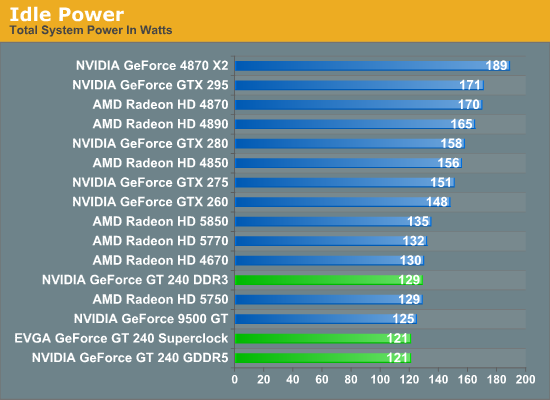
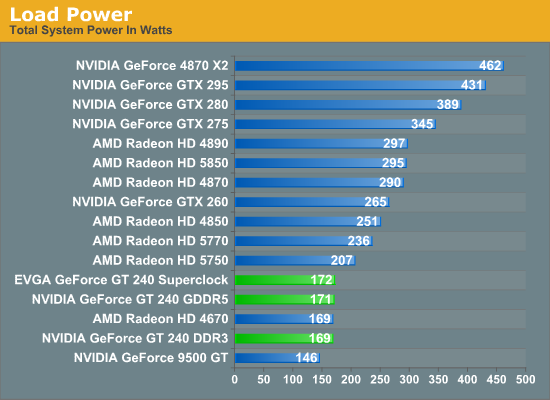
Due to some unrelated issues we don’t have the GT 220 in these charts, leaving the GDDR5 GT 240 as our least power-hungry card when it comes to idling. Unfortunately our DDR3 GT 240 refused to (or is simply not programmed to) idle, meaning that it comes in a good 8W higher than the GDDR5 versions of the cards. The lack of true idling for the DDR3 card will have some ramifications later.
Under load, these cards are still near the top of our charts. The only thing that’s significantly lower is the otherwise anemic 9500 GT while the Radeon 4670 is in a dead-heat. Between the GT 240 cards themselves, even with the different in RAM types, they’re all within 2W of each other. These would probably make fair HTPC cards, but the GT 220 should be a bit less power hungry and cooler.

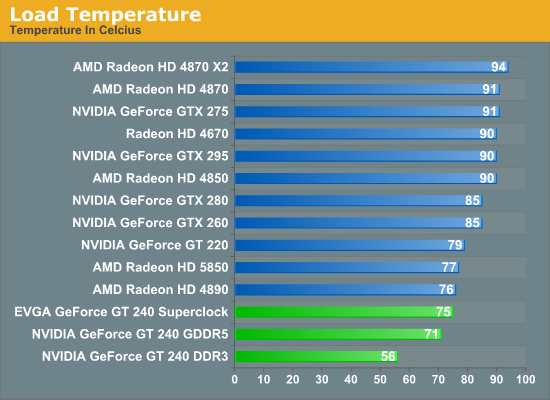
All of these cards push the limits of what’s practical for idle temperatures, although the Radeon 5850 is finally dethroned here by 2 of our GT 240 cards. The double-wide cooler on the Asus cards looks to be good for a couple more degrees than the single-wide cooler on the EVGA card is.
Load temperatures tell us a somewhat different story however. Ignoring the DDR3 card for a second, both the Asus and EVGA cards are quite cool. Our stock Asus card is some 8C cooler than our GT 220, and 19C cooler than the Radeon 4670. The EVGA card meanwhile is 4C cooler than the GT 220, and still 15C cooler than the 4670 in spite of the use of similar single-slot coolers. For what the GT 240 lacks in performance, it can certainly make up for in temperatures.
As for the DDR3 card, in spite of having the same cooler Asus has opted to run the fan at a higher speed. This makes it cooler, but as we’ll see it makes it louder too.
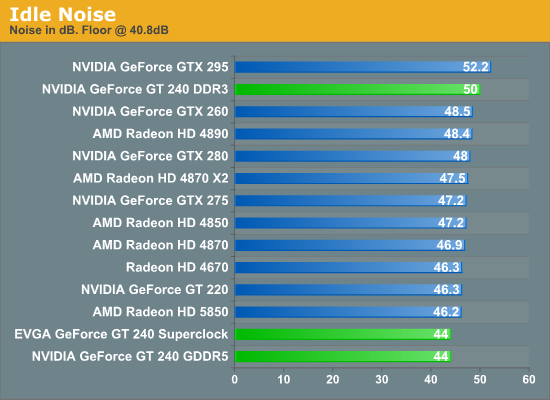
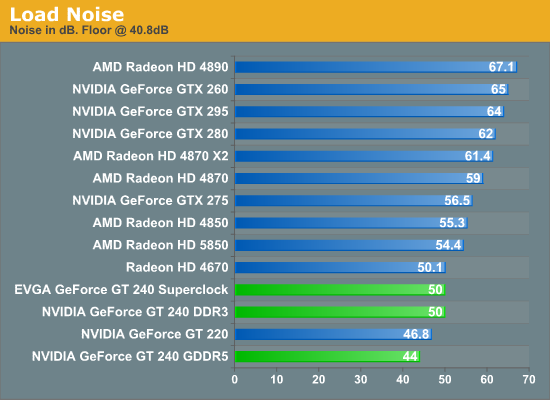
At idle, there’s not much of a story for the GDDR5 cards. They all run up against the ambient noise generated by the rest of the computer. Active and passively cooled cards are nearly indistinguishable at this point. The Asus DDR3 card however is quite distinguishable and is at the bottom of our charts. Its higher fan speeds means that it even idles at a pretty high speed, making it the second-loudest thing after the GTX 295.
It’s under load that the story takes a turn for the most interesting. At 50dB is the Asus DDR3 card and the EVGA card – the former continuing to use its high fan speeds, and the latter having to rev up to make up for its smaller single-slot cooler. Even at 50dB, these cards are quieter than everything besides the otherwise lower-powered GT 220.
Meanwhile down at 44dB is the Asus GDDR5 card, generating the same amount of noise as if it were idling. Based on these results, the card is for all practical purposes indistinguishable from a passively cooled card. Through the combination of a large fan and a large heatsink, the amount of noise the card generates falls below the ambient noise of the rest of the computer. The card is effectively silent.
Now we suspect that if we had a rig specifically for testing silent cards we would find a more notable difference, but in our i7 920 rig there is none to be found. The Asus GT 240 GDDR5 is the quietest actively cooled card we have tested to date, something we were not expecting to find on a GT 240 card. Also bear in mind that this the second-coolest card we have ever tested, falling behind only our overly loud DDR3 card. In the future, someone is probably going to make a very nice fully-passive card out of the GT 240 if all of this can be accomplished with the Asus cooler.










55 Comments
View All Comments
samspqr - Wednesday, January 6, 2010 - link
the cards are in shops already, firmly in 9800gt territory, and nearly 20% more expensive than 9600gt... but at these prices it means you're just paying a $10 premium in order to have the newer card; ati's replacement of 4870/4850 with 5770/5750 meant a much bigger premium for new-but-equally-performing tech (you had bigger power savings there, though)and, of course, I missed some comparisons with ATI cards in the conclusion, something to the tune of: "in any case, it is just sad that nvidia is unable to manufacture new chips to compete with anything ati has, other than a 4670"
nafhan - Wednesday, January 6, 2010 - link
The reason ATI can have a big premium on the 57XX (and 58XX) is that they've got no competition. The 57XX series in particular has PLENTY of room to drop in price as it's a much simpler card to build than the 4850/70 cards that it is replacing. Nvidia has similar performance for a similar price, but it's based on older tech with higher power consumption. The prices will probably stick until Nvidia comes out with a real challenger for the 5 series (i.e. Fermi).Spoelie - Wednesday, January 6, 2010 - link
Why is the GT240 only compared to nvidia cards in the entire review (except for the benchmark images)? It would be to the benefit of the reader to also know how it compares to ATi in the value for money area. What is the current price of say a 4670/4770/4850 in 512MB/1GB configurations and how would that compare in terms of value?Also, with such a small impact, I think the evga card should have been left out of the factory-clock benchmark graphs for future lookup convenience & easy relative comparison. The performance difference compared to the normal card could have been summarized on a dedicated page.
pugster - Wednesday, January 6, 2010 - link
http://www.newegg.com/Product/Product.aspx?Item=N8...">http://www.newegg.com/Product/Product.a...=AFC-Ben...Saw on newegg that you can get this 240gt with 1gb ddr3 memory for $58 after rebate.
plague911 - Wednesday, January 6, 2010 - link
I think the over all point was that you may as well not even consider the GT240. If you wanted a generic ATI/NVIDIA comparison you would use a different nvidia card. Not to say that nvidia may not beat ATI in a comparison but a different nvidia would be a better choice for the comparisonRyan Smith - Wednesday, January 6, 2010 - link
The 4800 and 4700 series have effectively been discontinued, the remaining cards are fairly rare and usually overpriced. There's little to gain comparing the GT 240 to a 4770 or 4850, as you can no longer get ahold of those cards for reasonable prices most of the time.That leaves the 4670, which the GT 240 beats.
hydrocarbon - Wednesday, January 6, 2010 - link
I can grab a 1GB 4850 off NewEgg now for a hundred and ten bucks, or a 512MB for a hundred. "Rare", sure, but "overpriced"? They're cheaper now than they've ever been, especially if you consider those are prices w/o rebates.MadMan007 - Wednesday, January 6, 2010 - link
Just FYI there is such a thing as the used video card market ;) while you can't compare pricing yourself and include it in the written details a savvy user who is looking at used cards will be able to do so.Taft12 - Wednesday, January 6, 2010 - link
Yes, but bear in mind the lack of warranty (XFX double lifetime notwithstanding) and unknown overclocking/stress history. These things make used video card purchases a non-starter.Taft12 - Wednesday, January 6, 2010 - link
... a non-starter IMHO of course